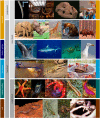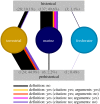Rethinking megafauna
- PMID: 32126954
- PMCID: PMC7126068
- DOI: 10.1098/rspb.2019.2643
Rethinking megafauna
Abstract
Concern for megafauna is increasing among scientists and non-scientists. Many studies have emphasized that megafauna play prominent ecological roles and provide important ecosystem services to humanity. But, what precisely are 'megafauna'? Here, we critically assess the concept of megafauna and propose a goal-oriented framework for megafaunal research. First, we review definitions of megafauna and analyse associated terminology in the scientific literature. Second, we conduct a survey among ecologists and palaeontologists to assess the species traits used to identify and define megafauna. Our review indicates that definitions are highly dependent on the study ecosystem and research question, and primarily rely on ad hoc size-related criteria. Our survey suggests that body size is crucial, but not necessarily sufficient, for addressing the different applications of the term megafauna. Thus, after discussing the pros and cons of existing definitions, we propose an additional approach by defining two function-oriented megafaunal concepts: 'keystone megafauna' and 'functional megafauna', with its variant 'apex megafauna'. Assessing megafauna from a functional perspective could challenge the perception that there may not be a unifying definition of megafauna that can be applied to all eco-evolutionary narratives. In addition, using functional definitions of megafauna could be especially conducive to cross-disciplinary understanding and cooperation, improvement of conservation policy and practice, and strengthening of public perception. As megafaunal research advances, we encourage scientists to unambiguously define how they use the term 'megafauna' and to present the logic underpinning their definition.
Keywords: apex predators; body size; functional traits; keystone species; large animals; megaherbivores.
Conflict of interest statement
We declare we have no competing interests.
Figures




References
-
- Gunn RG, Douglas LC, Whear RL. 2011. What bird is that? Identifying a probable painting of Genyornis newtoni in western Arnhem Land. Aust. Archaeol. 73, 1–12.
-
- Wallace AR. 1876. The geographical distribution of animals. New York, NY: Harper.
-
- Grassle JF, Sanders HL, Hessler RR, Rowe GT, McLellan T. 1975. Pattern and zonation: a study of the bathyal megafauna using the research submersible Alvin. Deep-Sea Res. 22, 457–481. (10.1016/0011-7471(75)90020-0) - DOI
-
- Martin PS. 1967. Prehistoric overkill. In Pleistocene extinctions: the search for a cause (eds Martin PS, Wright HE), pp. 75–120. New Haven, CT: Yale University Press.
Publication types
MeSH terms
Associated data
LinkOut - more resources
Full Text Sources
Research Materials
Miscellaneous
